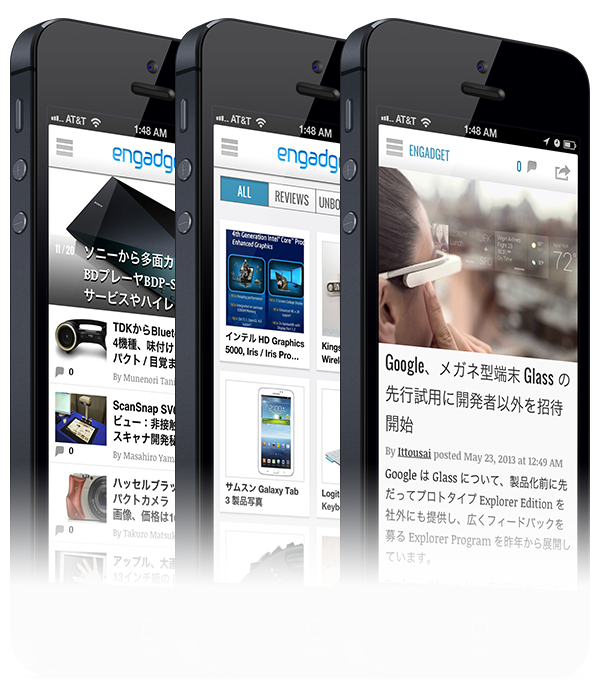

Engadget is a news, reviews and opinion outlet with obsessive coverage of cutting edge gadgets, consumer electronics and the science and technology they’re built upon.
Launched in March of 2004 as a web property, Engadget has since expanded to cover mobile devices and live events through video and photography in addition to the written word. Based on Technorati and Techmeme Engadget is consistently ranked in the top 25 of all active blogs and consistently in the top 10 of all active technology blogs. These figures are more impressive when you realize the total number of blogs tracked by Technorati as of Q2 in 2013 is 1.3 million.

The challenge put forth was a simple one, design a user experience that showcases content and minimize the intrusion of UI.
There was just one caveat, we had to make sure ALL of the content available on the desktop site was also accessible via the mobile app. This encompassed almost a decade of articles, reviews, buyers guides, podcasts, videos, live blogs, photo galleries, The Engadget Show and event subhubs. These event subhubs contained their own event-specific modules. The event subhubs also requied custom interfaces that changed over time, based on whether the user was consuming the content before, during or after these events. Systematic support of content generated by the foreign language entities of Engadget — starting with exclusive content from Engadget Japan — was also a requisite.
We had to do this while respecting existing legacy issues, advertising / sponsorship platforms, monetization, data-layers, tracking and various, constantly changing content feeds and CDNs. In order to meet all these needs, a phased rollout was enacted. A robust MVP would be released first with specialized content and features to follow in successive updates. All of this leads to the eventual launch of the app. Here’s the story behind the design — which doesn’t happen in a vacuum.
We had to do this while respecting existing legacy issues, advertising / sponsorship platforms, monetization, data-layers, tracking and various, constantly changing content feeds and CDNs. In order to meet all these needs, a phased rollout was enacted. A robust MVP would be released first with specialized content and features to follow in successive updates. All of this leads to the eventual launch of the app. Here’s the story behind the design — which doesn’t happen in a vacuum.

Engadget’s volume of content, and the core audience that demands access to said content, dictate that we deviate from the normal iOS tab navigation. In it’s place we use a left-drawer menu that would spring forth when the “hamburger” icon was tapped. Moving primary navigation off the home-screen allows us to upgrade Engadget's features, content and events modules dynamically without affecting the overall UI-UX and provides the user with more usable screen real estate.
A frequently updated and swipeable cache of DL (dynamic lead ) stories lead off the content pyramid with entry points for Engadget's own annual Expand Event. A never-ending feed of lazy-load articles rounds out the content stack.

The right drawer gives quick access to media allowing users to toggle between Podcasts and Videos. This is a boon for users who like to listen while they browse the Engadget articles. From most anywhere within the app the user is no further than two taps from the playback controls. The Engadget header icon also animates giving the user visual feedback while podcasts are playing.

Engadget fans demand a pure reading experience. In the 3.O release we pushed this to the extreme by allowing the user to toggle between the default and chromeless article view with a simple double tap.
Inline media is now showcased. Photo galleries are now surfaced with preview thumbnails, video is maximized, PR elements are accessible under tappable ribbons and call outs/quotes within Featured articles mimic their appearance in Engadget’s weekly periodical DISTRO. Articles end with related stories, tags and other relevant meta-data. Users can stay in the dedicated reading view by simply swiping to the next article.

What’s a true Engadget experience without access to all the Featured, Unboxing, Hands On and Engadget Show Videos and Galleries?

Within galleries, users can tap on the primary image within a photo gallery and indulge in a full-screen viewing experience that allows them to pinch to zoom and swipe through the entire gallery without excess chrome.

We’d be rude hosts if we didn’t let you save your
favorite content for later reading.

A redesign like this requires not only a fluid design, it requires a fluid development process. This necessitates living documentation that can be easily updated and distributed so lessons learned from micro-interactions can be recouped when extrapolated to the tablet experience and other platforms.

Engadget publishes content in English, Spanish, Japanese, German and both traditional and simplified Chinese. Many of the iterations of Engadget also publish content exclusive to their own localized website. In the US edition of Engadget v3.O for iOS, the first foreign langauge edition we are supporting is Japanese.
Currently, this encompasses only the primary feed of articles and dedicated galleries.

Any good app never stands still. In true Engadget form, v3.O is constantly evolving with some great surprises in upcoming future releases — we’ve also got planned updates with continued support for most major platforms.



